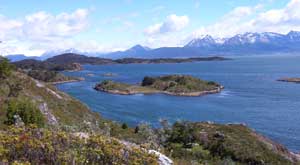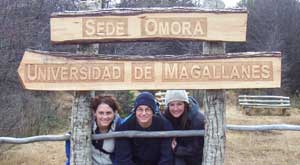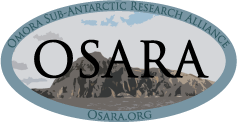|
|
|
|
|
|
|
|
|
|
|
|
|
|
Exploring the biocultural wonders of the
|
|
|
|
|
|
Tierra del Fuego Archipelago
|
|
|
The Tierra del Fuego
Archipelago is a world-renowned pristine and remote ecosystem that hosts
a unique biological and cultural diversity. In June 2005, the southern
portion of the archipelago was incorporated into the world network of
biosphere reserves by UNESCO’s Man and the Biosphere Program. In
addition, over 50% of the area is designated as state protected areas,
and the archipelago also hosts one of southern South America’s largest
private nature parks known as Karukinka.
As a result, many
institutions have an interest in developing research and education
programs in the area, while others wish to strengthen existing
initiatives. Since 2001, there has been an increasing need to
respond to this burgeoning array of projects in southern
Patagonia. The result of this four year process to better coordinate
these efforts has been the creation of the OSARA, a U.S.-based non-profit
whose mission is to promote biocultural
conservation by facilitating research and education with the
understanding that social wellbeing and sustainable development are also
part of long-term conservation goals in the islands south of the Strait
of Magellan.
|
|
|
|
|
|
|
|

|
|
|
|
|
|
|
|
|

|
|
|
|
|
|
|
|
|
|
OSARA strives to be a leader
in the efforts to understand, teach and protect the Tierra del Fuego Archipelago
and southern Patagonia. We believe that by coordinating the
activities of the different institutions with interest in the region we
can create a powerful consortium to achieve this goal. The long-term
goals of OSARA are modeled on the extremely successful example of the
Organization for Tropical Studies, which likewise is a joint venture of
sixty-three organizations. In this context, we seek to develop the
human and physical infrastructure necessary to carry out our mission with
the help of a network of people, institutions and projects
that together make-up the Omora Sub-Antarctic
Research Alliance.
Our
Mission:
OSARA promotes and supports
research, education and conservation in the Tierra del Fuego Archipelago and
southern Patagonia by:
- Facilitating research in
the social, natural and physical sciences, emphasizing the
integration among these areas and trans-disciplinary approaches;
- Offering educational opportunities
that emphasizes outdoor activities, experience-based learning,
natural history, and field environmental ethics courses, placing
into value traditional ecological knowledge, as well as scientific
forms of learning; and
- Placing importance on a
participatory approach in order for projects to have added
relevance via direct collaboration with local residents, government
officials and scientists, as well as providing a mechanism for
international participants themselves to be enriched through
reciprocal learning experiences in the local context and thereby
provide a scientific basis for policy and conservation
decision-making.
|
|
|
|
|
|
|
|
|
|

|
|
|
|
|
|
|
|
|
|
|
|